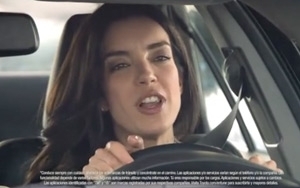automotive
Japanese Companies Lead Hispanic Consideration
- by Karl Greenberg , March 31, 2014
 Japanese automotive brands are doing the best job of reaching out to Hispanic consumers, finds a new report from Spanish-language media company Univision, with research executed in
partnership with GfK.
Japanese automotive brands are doing the best job of reaching out to Hispanic consumers, finds a new report from Spanish-language media company Univision, with research executed in
partnership with GfK.
The report says Hispanic sales are driving 20% to 30% of Toyota, Nissan and Honda's U.S. sales growth, and Hispanics are 29% more likely than non-Hispanics to report Honda, Toyota or Nissan first choice. And Toyota, Nissan and Honda are 15% more likely to be the first vehicle of choice for Hispanics.
Jack Randall, Univision SVP of business development, tells Marketing Daily that Ford and Toyota spend the most in Spanish language ads, followed by Chevy, Honda, Nissan. "They are actively communicating with Hispanic consumers with consistency, and culturally relevant in-language messaging," he says.
advertisement
advertisement
He says the three Japanese brands benefit from having a strong legacy with Hispanic consumers; from their vehicles appealing to the image and personality attributes that are preferred by Hispanic consumers; and from the Japanese being dominant on the West Coast, particularly in Hispanic-dense markets.
But Hispanics overall have lower auto brand awareness and loyalty than non-Hispanics, per the Hispanic GfK Upper Funnel Brand Tracker and Lower Funnel Shopping and Intentions Research. And that hasn’t changed, says Randall. “Univision has executed seven waves of this research, and this has been a consistent finding.”
One reason for the awareness issue is that marketers commit most Hispanic-media dollars to TV, while the general market media includes a lot more digital elements. "In English [general market], the media mix is much larger – giving brands more opportunity to garner awareness among consumers." But he says the Spanish language digital advertising investment is growing, though not yet on par with what's being done in the general market among manufacturers, "so this is a tremendous opportunity to increase awareness at scale."
The loyalty issue is due to a younger consumer demographic that is interested in experiencing different brands. And, notes Randall, there is a 60% greater chance that the younger Hispanic buyer will be a first-time buyer versus younger non-Hispanic buyers; there is a 52% greater chance that they will be adding to a fleet rather than replacing a car. "This poses a tremendous opportunity for brands to nurture the Hispanic customer early in the auto-purchasing life cycle and forge a life-long relationship with them."
The non-Japanese brands are doing much better at this than they have in the past, says Randall, who adds Ford, GM and Chrysler have long-term relationships and consistently message to Hispanic consumers both nationally and regionally. He says VW and the Korean manufacturers – Hyundai and Kia — are also now marketing heavily against Hispanic consumers. "All of these brands have seen successes as a result of their commitment to communicating with Hispanic consumers."
Randall says the keys to success are consistency of messaging; consistency of communication across Tier 1, 2 and 3; an engaged dealer body; surrounding the consumer with messaging across all touch points, especially given that Hispanics over index on social and mobile; tapping into passion points (e.g., entertainment, sports, music, family) with in-culture and in-language communication. "Hispanic marketing has to be a strategic imperative from the C-Suite, supported from the top across the company. E.g. Kia – when we see brands tap into culture and language via passion points, we see increases in awareness and sales."




